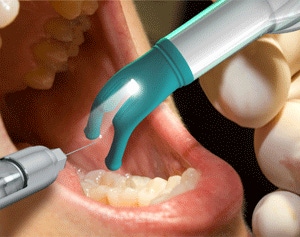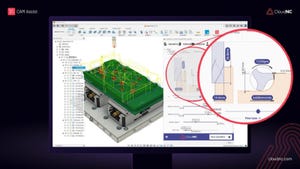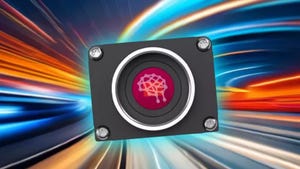DentalVibe Tricks Brain to Cut Pain
May 4, 2010

Dentistryhas made huge strides since the 19th century ads for painlessdentists, but fear of pain still keeps many people from getting dental workdone. Electronic technology is helping dentists reduce pain by tricking thebrain so patients barely notice the injections of anesthetics.
Dentists long ago noticed that if they vibrated the check area around the spotof the injection needle's entrance, nerve signals were interrupted so patientsfelt less pain. Florida dentist, Dr. Steven G. Goldberg, decided to capitalizeon this idea. He first used a vibrating flosser but decided to commercialize amore rugged product, so he linked up with an engineering team to create DentalVibe, a device now being marketed todentistry offices.
"We provide a vibrating lip retractor that stimulates the region and has alight to illuminate the area," says Dave Schiff, director of engineeringat Bresslergroup, the Philadelphia contract design house that designedDentalVibe. The fork on the handheld tool vibrates while the dentist injectsanesthetic into the patient gums, pointing the needle between the prongs of thefork.
The engineers use an eccentric cam to vibrate the fork, which is covered withrubber so it's soft enough to be comfortable for patients. Finding the rightdurometer rubber to permit vibration was a challenge, as was figuring out howto trick the brain so it doesn't adjust for the vibrations and let pain signalsgo to the brain.
"We run at about 120 Hz with 0.5 mm of amplitude. We found that if it ison for about a second then turns off briefly, it keeps refreshing signals tothe brain and continuously masks the pain," Schiff says.
Fitting a powerful motor into the handle was a key design challenge, one thatrequired getting the most vibration from the smallest motor. "One concernwas to get the maximum force so we use a dc motor that delivers the most torqueon the 1.2V the battery supplies," Schiff says.
Making the unit compact and light were also critical elements in the design.The unit can't take up much space and it can't be bulky. The motor, lightsource and battery fit in the handle. A light pipe permits illumination at thepoint of injection while letting designers keep the fork thin so it's not intrusivefor patients.
It uses a rechargeable battery that easily lasts the 30 seconds or less thatit's activated for injections. Simplicity in design was important to keep costsdown and ensure that electronics aren't damaged during the many washdowns enduredby dental equipment. "It's a three-part, overmolded assembly that uses alight pipe to shine the light where the dentist will be making theinjection," Schiff says.

DentalVibe Tricks Brain to Cut Pain_B
About the Author(s)
You May Also Like





